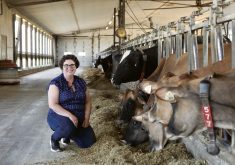It can seem like there’s no end of stories, opinions and advice to help farmers transition the farm business to the next generation. But how do you transition yourself? How do you live with retirement?
Volunteering helped Shirley Lahn and her late husband Howard when they were busy farming, and then through the transition and ensuing years. They ran a dairy farm northwest of Hanover, Ont., until 1996 when they switched to beef farming.
In 2019, Shirley received her 25-year volunteer service pin from Home and Community Support Services of Grey-Bruce, where she remains involved.
Read Also

Are you ready for farm succession?
What motivates some farmers to make a succession plan while others don’t seem worried.
Lahn has delivered hot meals to people in the countryside, visited isolated people in the area, and currently helps out with the day program at the centre in Hanover.
“It gives me joy, and I get as much out of it as the people I help,” she says, adding that since she lives alone, she enjoys the social interaction of the program.
Research shows benefits
According to research, volunteering has also probably helped Lahn maintain good mental and physical health.
There are many studies that back up the fact that volunteering — especially for older people — increases satisfaction and a sense of self-worth, reduces depression and even prolongs life.
Research published by the Carnegie Mellon University in Pittsburgh in 2013 found that volunteering actually helps reduce hypertension, which is a major cause of heart attacks and strokes. Further, it found that the more time people volunteer, the better the results. The sample was a cross-section of more than 6,500 50-plus-year-olds who were surveyed in 2006 for a baseline, and then again in 2010. Individuals who volunteered more than 200 hours a year were less likely to develop high blood pressure than non-volunteers.
In another study out of the University of Buffalo, a correlation was found between the buffering effect of charitable behaviour and people’s ability to handle stress and the physical problems that come with it.

Support services available for rural areas
Home and Community Support Services of Grey-Bruce is part of a network of organizations that provide help for anyone over the age of 18, including older citizens so they can “live independently and stay in their own home as long as possible.”
Megan Kanters, who’s in charge of volunteer development at the Hanover location, figures about 300 to 400 clients a day are served in an area that covers all of Bruce and Grey counties.
“At least half of our clients are farmers,” she says. Some have Alzheimer’s disease or dementia.
Besides the Meals on Wheels, transportation, day and visiting programs, Kanters says the Owen Sound and Hanover centres provide overnight respite so caregivers can take a break. Clients are provided with a bed, meals and planned activities while being cared for by qualified staff over the weekend. Housekeeping services are also available for those who need help with household chores and meal preparation.
“People in the agriculture industry really enjoy talking with others who have the same background,” Kanters says. “The social connection fills them up and they feel connected to the community again.”
Across Ontario during 2017-18, the network provided 730,000 individuals with home care, delivered more than three million Meals on Wheels and facilitated nearly two million rides to doctor, dental, hair appointments and more. Almost 50,000 people took advantage of day programs, like the one Shirley Lahn helps with. Clients come or are brought into the centre to socialize and have a hot, home-cooked meal.
“We chat with the clients, play card games and crokinole, and serve and eat lunch with them,” Lahn says.
After lunch is time for a little rest and entertainment, which sometimes includes live music and dancing. Lahn volunteers two or three days a week from 9 a.m. to 3 p.m. The service is available six days a week.
In the past, she participated in the “friendly visiting program,” in which she was paired up with people of similar interests who lived out in the country and didn’t have family close by. She’d drive out to visit at their places once a week for a couple of hours.
All of the services are available for a nominal fee, except for friendly visiting, which is free. For example, Meals on Wheels has hot meals ranging from $7.75 to $9 and there’s a Frozen Meals on Wheels option available for $35 for seven entrees.
Drawing on her personal and very positive experience, Lahn recommends volunteering for anything.
Says Lahn, “There’s lots of volunteers needed out there in many different programs.”
Where to find help
211 is a nationwide service available in 150 languages and provides 24/7 access to Canadians for health and social services in their community. 211 gives those who use it advice and recommendations on services that best meet their needs. Users do not need to provide personal information. The service is available online (211.ca), by phone (2-1-1), by text and by chat.
How to find volunteer opportunities
A really good resource for finding volunteer opportunities in your part of Canada is at the Canada Volunteer Directory. It lists the different charitable organizations in each province and where to go for information on volunteering. Filters are available for location and category (e.g. family support, libraries, animals, adult learning, mental health, etc).















